
Long Beach insisted that the last voyage (the delivery voyage) be run as a cruise. This was much to Cunard's annoyance, who wanted a simple delivery job.
A slow passage was planned using only 2 of the ship's 4 propellers to save fuel. The other 2 props dragged free in the water. Like this she could use as little as 550 tons of fuel per day, instead of 1000 or more.

Photo taken on the last voyage. The two center props only were used.
The trip round Cape Horn was to be particularly strange for some, as the Queen Mary carried two London buses, and some passengers boarded them so that they could say they had traveled round the Cape in a London Bus.

Passengers board a bus to travel round Cape Horn.
The ship could not carry enough fuel for the whole trip, and had to make seven stops on the way:
31st October, 1967, Southampton to....
.....to Long Beach (Dec 9th, 1967)

A program cover for the last cruise
Arrival in Long Beach was a jubilant affair and the ship was first met by a DC9 jet about 500 miles from port. As she entered Long Beach harbor, thousands of small boats came out to meet her.

The ship is given a warm welcome to Long Beach, her new home.
This was the end of an era. The end of the old, luxurious way of transatlantic travel. The Queen Mary's boiler fires went out when the ship was berthed, and "Finished with Engines" was signalled to the engine room via the telegraphs. The Queen Elizabeth had also been sold to a group of businessmen and was moored for a while in Florida. She burned out completely in Hong Kong harbor in 1972.

This photo was taken just after the Queen Mary's boilers had been allowed to go out. It may be the last photo ever taken of them. Compare this with the boiler rooms as they appear today (see the Virtual Tour on this site).
For the Mary though, there would be a new lease of life that would completely transform her. Work now began on one of the biggest ship-conversion jobs ever attempted.
Contrary to popular belief, Long Beach did not buy the Queen Mary to preserve her. They needed her for another reason. Since oil was discovered in California, some of the money raised from it had been set aside in a fund called the "Tidelands Oil Fund". Some of this money was allocated in 1958 to buy a maritime museum for Long Beach at some time in the future. The Queen Mary had now been chosen to act as the host for this museum, and had been purchased as a conveniently sized building with a name attached to it. It only occurred to a very few people in 1967 that the destruction of the engineering and so many other areas of the ship would ever be regretted.